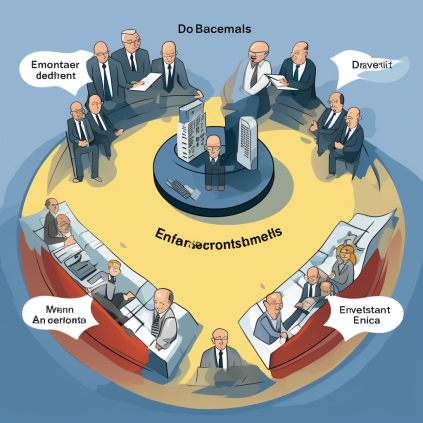Introduction
Software Portfolio Governance Models: is the compass that guides organizations through the complex waters of software management. In the modern digital age, where software is the lifeblood of businesses, having a well-defined governance model is crucial. This blog will explore various software portfolio governance models, their unique attributes, and provide examples to illustrate their importance in ensuring efficient software management.


Software Portfolio Governance Models
Table of Contents
The Significance of Software Portfolio Governance Models
Before we delve into the governance models, it’s essential to understand why software portfolio governance matters:
- Alignment with Business Goals: Governance models ensure that software investments align with the strategic objectives of the organization, enabling businesses to derive maximum value from their software assets.
- Risk Mitigation: They help identify and mitigate risks associated with software, such as security vulnerabilities, compliance issues, and operational disruptions.
- Resource Optimization: Governance models optimize resource allocation by streamlining software procurement, maintenance, and retirement processes.
- Compliance and Legal Frameworks: They ensure that software usage complies with licensing agreements, copyright laws, and industry regulations, preventing costly legal complications.
- Cost Control: Governance models control software acquisition and maintenance costs, allowing organizations to allocate budgets effectively.
Software Portfolio Governance Models


Software Portfolio Governance Models
1. Centralized Governance
Overview: In this model, a central authority, typically an IT department, holds the decision-making power regarding software acquisition, deployment, and management. It offers a high level of control and visibility over the entire software portfolio.
Example: A large multinational corporation centralizes software decisions to ensure uniformity and compliance across all subsidiaries and departments. The IT department approves and manages all software purchases and licenses.
2. Federated Governance
Overview: In the federated model, decision-making authority is distributed among various business units or departments. Each unit manages its software portfolio independently, which can be beneficial for specialized needs but may lead to fragmentation.
Example: A university adopts a federated governance approach where different faculties or departments have autonomy over their software choices. The central IT department provides guidelines and support but allows individual units to decide their software needs.
3. Decentralized Governance
Overview: Decentralized governance gives full autonomy to individual business units or departments in managing their software portfolios. While it promotes agility, it can also result in challenges like redundancy and compliance issues.
Example: A startup company encourages each department to select and manage its software tools without central interference. This approach fosters innovation but may lead to uncontrolled software sprawl as the organization grows.
4. Hybrid Governance
Overview: As the name suggests, this model combines elements of centralized and decentralized governance. It provides a framework for central control over critical software while allowing flexibility for specific departments or teams.
Example: A hospital employs hybrid governance for its software portfolio. It centrally manages core healthcare software like Electronic Health Records (EHR), ensuring compliance and data security. However, individual departments have the flexibility to choose additional software for their specific needs.
5. Coordinated Governance
Overview: Coordinated governance focuses on collaboration and communication between various stakeholders involved in software decision-making. It emphasizes consensus building and ensures that software choices align with organizational goals.
Example: An advertising agency adopts coordinated governance for its software portfolio. Regular meetings involve representatives from IT, creative teams, and project managers to decide on software tools that enhance creative workflows while meeting IT security standards.
6. Outsourced Governance
Overview: In this model, organizations partner with external experts or vendors to manage their software portfolios. This approach can help offload the complexities of software management but requires careful vendor selection and management.
Example: A medium-sized manufacturing company outsources its software portfolio management to a specialized Managed Service Provider (MSP). The MSP handles software procurement, updates, compliance, and support, allowing the company to focus on core operations.
Selecting the Right Software Portfolio Governance Models
Choosing the most suitable Software Portfolio Governance Models depends on an organization’s size, industry, culture, and objectives. Here are some key considerations:
- Organizational Culture: Consider the organization’s willingness to centralize decision-making or grant autonomy to different units.
- Complexity of Software Portfolio: Evaluate the diversity and complexity of the software tools used. Highly regulated industries may benefit from more centralized governance.
- Compliance and Security: Industries with stringent compliance and security requirements may lean towards centralized or coordinated governance models.
- Resource Allocation: Assess the available resources for software portfolio management, including budget, personnel, and expertise.
- Scalability: Consider how the chosen model can adapt as the organization grows and its software needs evolve.
Example Scenario
Imagine a mid-sized e-commerce company, “TechTrends,” that is expanding rapidly. They have a diverse software portfolio, including e-commerce platforms, customer relationship management (CRM) software, and data analytics tools. To navigate their software governance challenges, TechTrends decides to implement a hybrid governance model.
In this model, they centralize control over their core e-commerce platform to ensure consistency, security, and compliance. Meanwhile, individual departments, such as marketing and analytics, are given autonomy to choose software that aligns with their specific needs. The central IT department coordinates regular meetings to foster collaboration, address concerns, and evaluate the performance of selected software tools.
This hybrid approach allows TechTrends to strike a balance between centralized control and departmental autonomy, ensuring efficient software management while promoting innovation and flexibility.
Software Portfolio Governance Models : Conclusion
Software portfolio governance is the compass that helps organizations navigate the ever-expanding sea of software choices. The right governance model ensures alignment with strategic goals, risk mitigation, resource optimization, and cost control. Whether an organization opts for centralized, federated, decentralized, hybrid, coordinated, or outsourced governance, the key is to select the model that best suits its unique needs and aspirations. With effective software portfolio governance, organizations can harness the power of software to drive their success in the digital age.

